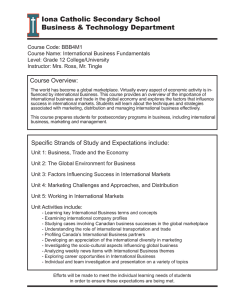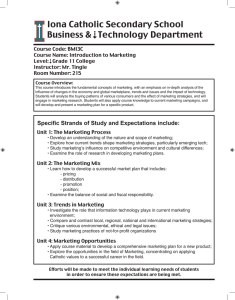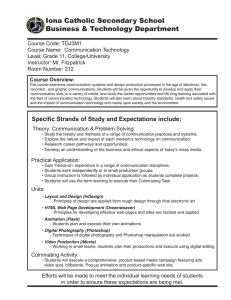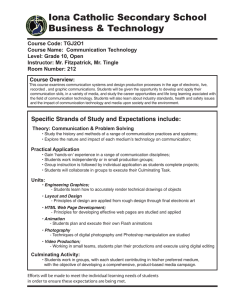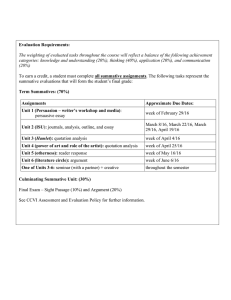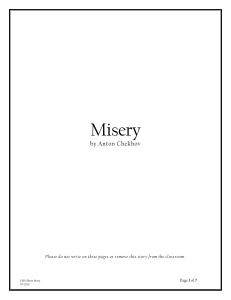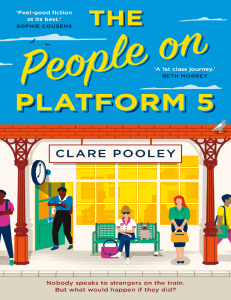Iona Catholic Secondary School Business & Technology
advertisement
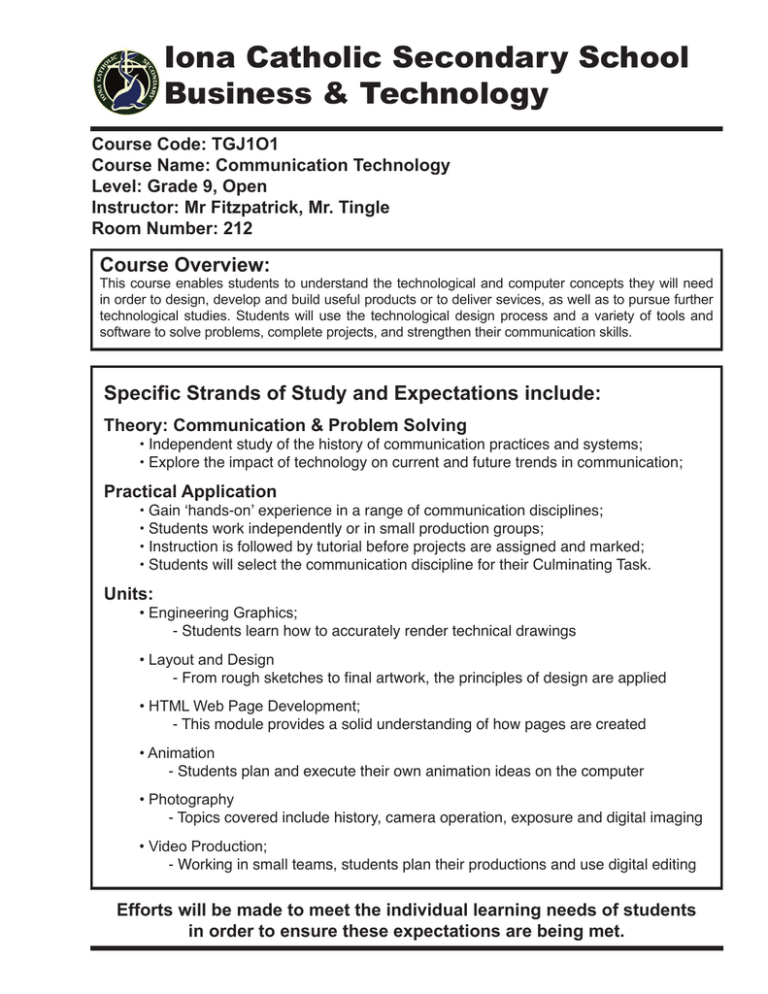
Iona Catholic Secondary School Business & Technology Course Code: TGJ1O1 Course Name: Communication Technology Level: Grade 9, Open Instructor: Mr Fitzpatrick, Mr. Tingle Room Number: 212 Course Overview: This course enables students to understand the technological and computer concepts they will need in order to design, develop and build useful products or to deliver sevices, as well as to pursue further technological studies. Students will use the technological design process and a variety of tools and software to solve problems, complete projects, and strengthen their communication skills. Specific Strands of Study and Expectations include: Theory: Communication & Problem Solving • Independent study of the history of communication practices and systems; • Explore the impact of technology on current and future trends in communication; Practical Application • Gain ‘hands-on’ experience in a range of communication disciplines; • Students work independently or in small production groups; • Instruction is followed by tutorial before projects are assigned and marked; • Students will select the communication discipline for their Culminating Task. Units: • Engineering Graphics; - Students learn how to accurately render technical drawings • Layout and Design - From rough sketches to final artwork, the principles of design are applied • HTML Web Page Development; - This module provides a solid understanding of how pages are created • Animation - Students plan and execute their own animation ideas on the computer • Photography - Topics covered include history, camera operation, exposure and digital imaging • Video Production; - Working in small teams, students plan their productions and use digital editing Efforts will be made to meet the individual learning needs of students in order to ensure these expectations are being met. Resources: TGJ1O1 The course will use a variety of resources to provide students with a comprehensive learning activity: • On-Line text resources, Iona Website course page; • Students are responsible for keeping organized notes of lecture material - including missed classes; • Handouts and reprints of articles; • Print and on-line internet research; • Returned tests and assignments should be kept for study reference; • Students are required to pay a nominal fee for supplies; • NOTE: STUDENTS ARE RESPONSIBLE FOR THE CONDITION OF ALL EQUIPMENT THEY USE. Evaluation Structure: Term and Summative work is weighted in 4 categories • Knowledge/Understanding.......20% • Thinking....................................20% • Communication........................20% • Application................................40% The above is reflected in the term work (worth 70% of the final mark) and the summative work (worth 30% of the final mark) Summative work consists of: 30% Culminating Activity (Practical Production) Evaluation Policy Students will be assessed and evaluated according to the work produced and skills displayed. Methods of providing feed- back will include assessing work in process and evaluating completed assignments, tests, co-operative learning activities, simulations and presentations. Peer and self-evaluations will also be utilized. Student marks will be determined by evaluating process and product according to 4 categories and 4 levels. The chart below defines the specific skills and key words used to determine student competency in the different categories: Category Level Knowledge & Understanding • Knowledge of facts and terms • Understanding of concepts and relationships Thinking • Critical thinking skills • Creative thinking skills • Inquiry skills Communication Level 1: 50 - 59% Limited display of knowledge, skills and ability to apply concepts. Level 2: 60 - 69% Level 3: 70 - 79% Some success in displaying knowledge, skills and application of concepts. Considerable display of knowledge, skills and ability to apply concepts. Level 4: 80 - 100% Thorough understanding of concepts and ability to communicate, think creatively and apply concepts. • Communication of ideas and information • Use of symbols and visuals • Oral and written presentation Application • Applications in familiar contexts • Transfer of concepts to new contexts • Making logical conclusions and predictions • Use of technology The following student learning skills are assessed independently and feedback provided on reports: Responsibility, Organization, Independent Work, Collaboration, Initiative and Self-Regulation E = Excellent G = Good S = Satisfactory N = Needs Improvement Other Evaluation Issues • Late assignments will be accepted in accordance with Board policy as detailed in the Student Agenda; • No assignments will be accepted after the instructor returns the marked assignments; • Repeated lateness in submitting work indicates poor organization skills and will result in parental contact; • Students are obliged to follow the Board’s policy on computer use any misuse will result in consequences; • Plagiarism, in any form, reflects academic dishonesty and will reult in a mark of zero for the assignment; • Students are expected to be prepared for all class work, and attend wearing the full Iona uniform properly; • All students are bound by the policies and procedures detailed in the Iona Student Agenda, with consequences as outlined - including administration involvement and parental contact.
